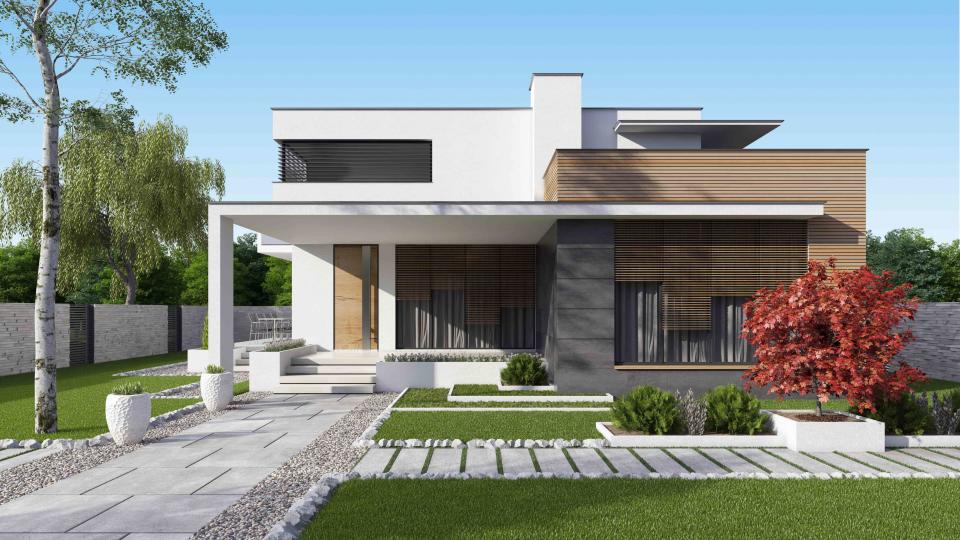What Is Modern Architecture? Here's a Rundown
Find out the history and defining characteristics of this popular architecture style.

Tulcarion/Getty Images
The first thing you might notice about modern architecture is that while it does share a general set of key characteristics, each home is different in its own way. The style allows for freedom of expression versus rigid rule-following, leverages modern materials, and places a strong emphasis on form-meets-function.
“The appeal of modern architecture is the opportunity to create something unique with a focus on openness and visual connections to the natural and built surroundings,” says architect Jan Brenner, associate principal at CambridgeSeven. “It inherently gives the architect the opportunity to interpret the site and its materiality and use those cues as a starting point of design.”
Ahead, we’re exploring the origination and evolution of modern architecture, and outlining some defining traits of this iconic style.
Related: 13 Different House Styles to Know if You’re Shopping for a Home
A Quick Historical Overview of Modern Architecture
Modern architecture is rooted in 1900s Europe, and is associated with a social uprising against the bourgeoisie, Brenner notes. At this time, everyday people had access to new materials and technology—not just the rich—which triggered a shift from classic architectural styles to something, well, a bit different.
“Classical architecture was viewed by the founders of modernism as a style of excess and embellishment with unnecessary decoration,” Brenner explains. “By using modern materials and technology, architects could focus on functionalism with larger unencumbered views through large windows and open spaces in long spanning structures.”
He adds that modernism also bestowed architects with something they’d never really had before: freedom of expression. Instead of being bound by the prescriptive rules of existing architectural standards, they were free to experiment.
"Architects—such as Frank Lloyd Wright, Le Corbusier, and Mies van der Rohe—believed that buildings should be designed to be functional and efficient, and that it should reflect the modern world,” explains Bernadette Cuaycong, design manager at Block Renovation. “They focused on how people lived, worked, and moved from space to space rather than the ornamentation that would embody every crevice of each space.”
Modern architecture has evolved over time; it's perhaps less industrial and “cold” compared to early iterations of the style. Brenner says that today’s modern architecture often incorporates warm natural materials versus that stripped-down glass, steel, and concrete of the past. Still, modern architecture deeply embraces the idea of artistic freedom and innovation.
6 Defining Traits of Modern Architecture
While modern architecture has evolved—and each house or building is unique in its own way—it does tend to include a handful of key characteristics.
Flat or Low-Pitched Roofs
Modern architecture often features flat or low-pitched roofs as opposed to traditional sloped roofs. “This design choice reflects the movement's desire to emphasize simplicity and reject ornate, historical elements,” Cuaycong explains. “Flat roofs provide a clean, minimalistic look and can serve as functional spaces for rooftop gardens, solar panels, or outdoor terraces.”
Minimalism and Clean Lines
Similarly, modern architecture embraces simplicity via clean lines and little to no ornamentation. “This creates open, elegant, and inviting spaces,” says Cuaycong. “While lines exaggerate space—making it feel longer or taller than it appears—it can help create a balanced composition in an asymmetrical space.”
Large Windows
Big, sweeping windows that allow natural light to flood the room are a common theme in modern architecture. “You see this via sliding doors and glass walls in addition to standard windows in lots of contemporary homes in places like California,” Brenner notes. “These large windows offer a connection to the outdoors and promote a seamless indoor-outdoor living environment.”
Open Floor Plans
The open floor concept (versus compartmentalized spaces) is a key trait of modern architecture. “With open floor plans, you get visual continuity with the opportunity for larger spans and sweeping views and vistas free of obstructions,” notes Brenner. He adds that this sense of openness and freedom is appealing to the human eye, but that it also allows spaces like kitchens—which were once tucked out of sight—to serve as beautiful showpieces.
Exposed Structure
While more traditional homes often feature things like wallpaper and more prominent decorative elements that cover the building’s structural elements, modern architecture exposes materials for what they are. “This style showcases the physical bones of the structure with things like exposed beams and celebrates their authentic beauty by keeping them in plain view rather than hiding them behind decor,” Brenner says.
Use of Modern Materials
Today’s modern architecture embraces a combination of both industrial elements—like steel, glass and concrete–and natural materials like wood and stone. This mixture allows for lots of natural light (glass), durability (steel and concrete) and tonal warmth (wood and stone).
For more Real Simple news, make sure to sign up for our newsletter!
Read the original article on Real Simple.


